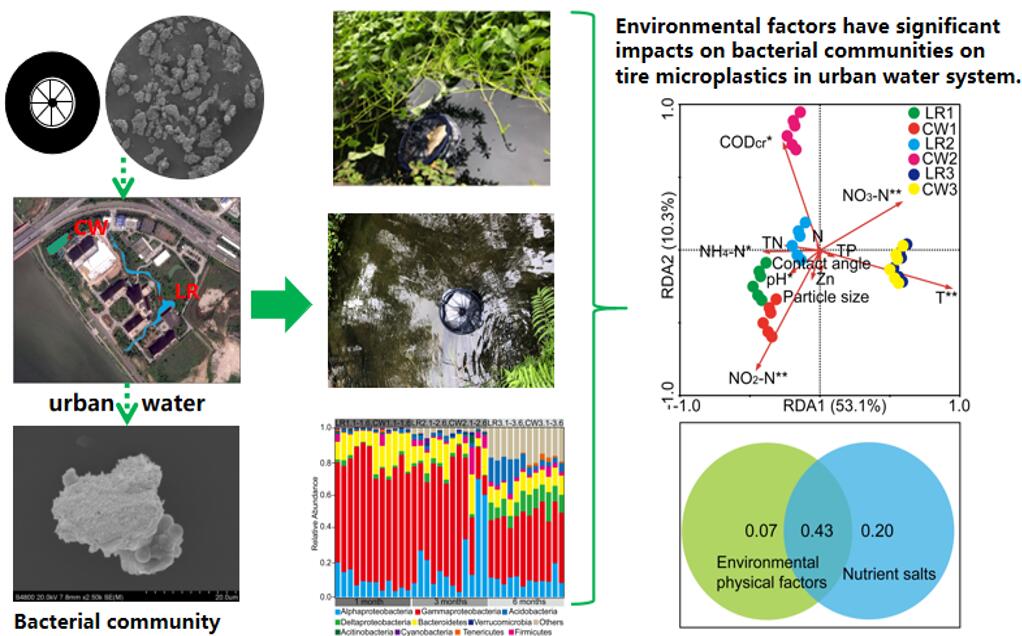Tire microplastics are considered one of important microplastics, which is the second largest contributor of primary microplastics to marine environment on global scale. Tire microplastics mainly derive from tires used on roads even though tires are made to be highly wear-resistant, which are very easy to enter the urban water environments with the way of atmospheric settlement, rainwater, surface water flow, etc. Subsequently, they may accumulate in the landscape rivers and the constructed wetlands which are designed to treat rainwater and urban runoff, in turn form as one of the important pollutants in urban water environment. Substantial evidences showed that microplastics can be one of microorganisms’ carriers in the aquatic environment, and the microbial communities are the important components of the aquatic ecosystem, which are of vital importance to the recycling process of carbon, nitrogen and pollutant degradation, etc. Therefore, it is of great significance to investigate the bacterial communities on the tire microplastics and the impacted factors to evaluate the potential ecological risk of the tire microplastics in the urban water environments.
There is so far relatively few information on microorganisms colonized on tire microplastics, which hampers the accurate assessment of its ecological risk in urban water environments. ZhuanXi Luo, an associate professor in Changzhou Yan’s research group, took together with Anyi Hu, an associate professor of Changping Yu’s research group, the associate professor Xiangyu Lin of the Shaohua Chen’ research group to carry out a first study on the bacterial communities colonization on tire microplastics in typical urban water environments and associated impacted factors. Three different brands and sizes of tire microplastics were selected and placed in two typical urban water environments, i.e. constructed wetland and landscape river, and after three time periods, the bacterial community on the tire microplastics was characterized, respectively. This study also discussed critically the influence of different water quality factors and different physio-chemical properties of the tire microplastics on the bacterial communities, and thus evaluated the ecological risk scientifically. Results showed that the abundance of bacterial colonization on tire microplastics increased over time. Proteobacteria, Bacteroidetes were the dominant bacteria at a phylum level, although they exhibited dynamic changes. At a genus level, the identifiable bacteria found in tire microplastics was generally the common bacteria in wastewater discharge, such as Aquabacterium and Denitratisoma. Additionally, alpha diversity showed no significant differences in bacterial communities at the same locations. While beta diversity showed that the bacterial communities on the tire microplastics in the two locations was different. BugBase revealed that tire microplastics could support pathogenic bacteria in urban water environments. PICRUSt indicated that the abundance of microorganisms associated with metabolism and degradation increased with time. Moreover, the ambient environmental factors were the main influencing factors of bacterial communities on tire microplastics. Herein, the contribution rate of nutrient salts (NO2-N, NO3-N, NH4-N, CODcr) was approximately 63%, and that of environmental physical factors of T and pH was approx. 50%. While physicochemical factors, including particle size, contact angle, element content only had a slight impact. Accordingly, tire microplastics, as an emerging environmental pollutant, can act as vectors for bacterial colonization and propagation, particularly harmful microorganisms, and the composition and structure of bacterial community would change over time, as well as the functional diversity. This carried role in microorganisms on tire microplastics would lead to the unpredictable ecological risk to urban water environments. Therefore, the obtained findings can provide new insight into potential risks of harmful microorganisms that colonize tire microplastics and their potential influences on ecological process of carbon, nitrogen and pollutant degradation, etc. in urban water environments.
The abovementioned findings have been published in top international journals in the field of environmental science: Environmental Pollution, 2020, (Liyuan Wang, Zhuanxi Luo*, Zhuo Zhen, Yu Yan, Changzhou Yan, Xiaofei Ma, Lang Sun, Mei Wang, Xinyi Zhou, Anyi Hu. Bacterial community colonization on tire microplastics in typical urban water environments and associated impacting factors). Here, the first author is Liyuan Wang (Master student), and the corresponding author is Dr. Zhuanxi Luo. This study was financially supported by the Key Projects for Intergovernmental Cooperation in Science, Technology and Innovation, the Nature Science Foundation of Fujian Province and the Scientific Research Funds of Huaqiao University.

Graphical abstract of Bacterial community colonization on tire microplastics in typical urban water environments and associated impacting factors.